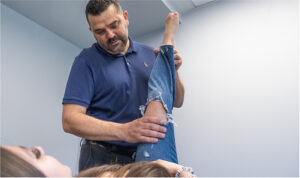Neck Pain Physical Therapy
Overview
Neck pain is a common condition that can affect day-to-day activities, posture, and work. It often results from poor posture, muscle strain, or underlying conditions. People experiencing neck pain accompanied by numbness, weakness, or pain radiating down the arm should seek medical attention promptly.
Symptoms
Common symptoms of neck pain include:
- Discomfort that worsens with prolonged head positioning, such as during computer use or driving.
- Muscle tightness or spasms.
- Reduced range of motion.
- Headaches originating from neck strain.
Causes
The neck plays a crucial role in supporting the head, making it vulnerable to injuries and degenerative changes. Common causes of neck pain include:
Muscle strain: Overuse or prolonged poor posture—such as looking down at a phone or hunching over a computer—can lead to muscle fatigue and strain.
Nerve compression: Herniated discs or bone spurs can press on spinal nerves, causing pain that may radiate down the arms.
Trauma and injury: Sudden movements, such as whiplash from an auto accident, can overstretch neck muscles and ligaments.
Joint degeneration: Aging can contribute to wear and tear on the cervical spine, leading to osteoarthritis and the formation of bone spurs.
Underlying medical conditions: Rheumatoid arthritis, meningitis, and certain cancers can present with neck pain as a symptom.
Preventing Neck Pain
Preventing neck pain involves maintaining proper posture, staying active, and reducing strain on the cervical spine. Consider the following strategies:
- Practice good posture. Keep shoulders aligned with the hips and ears positioned over the shoulders.
- Adjust workspace ergonomics. Ensure the computer monitor is at eye level and avoid prolonged neck bending.
- Take breaks. If working at a desk or traveling for long hours, take frequent breaks to stretch and reposition.
- Sleep in a supportive position. Use a small pillow under the neck and avoid sleeping on the stomach.
- Stay active. Regular physical activity can help maintain spinal health and flexibility.
How Physical Therapy Can Help
Physical therapy plays a key role in relieving neck pain by addressing muscle imbalances, improving posture, and restoring mobility. Common physical therapy practices include:
- Manual therapy to reduce muscle tension and improve joint function.
- Postural training to correct misalignment and prevent strain.
- Targeted exercises to strengthen supporting muscles and increase flexibility.
- Heat and cold therapy to manage inflammation and discomfort.
- Dry needling and massage therapy for deep muscle relaxation and pain relief.
Request an Appointment
If you are experiencing persistent or worsening neck pain, physical therapy may provide effective relief. Contact Us today to receive a personalized treatment plan tailored to your condition.


